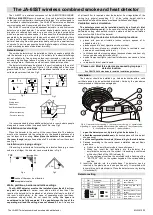
D900-00-00
1
I56-0003-002R
SpectrAlert
™
Electronic Chime/Sounder
For use with the following models:
Chime/Sounder: 12/24 volt: CH12/24
Add suffix “W” for white models.
INSTALLATION AND MAINTENANCE INSTRUCTIONS
A Division of Pittway
3825 Ohio Avenue, St. Charles, Illinois 60174
1-800-SENSOR2, FAX: 630-377-6495
www.systemsensor.com
General Description
The SpectrAlert series notification appliances are designed to meet the
requirements of most agencies governing these devices, including: NFPA,
The National Fire Alarm Code, UL, FM, CSFM, MEA. Also, check with
your local Authority Having Jurisdiction for other codes or standards that
may apply.
The SpectrAlert series can be installed in systems using 12- or 24-volt pan-
els having DC or full-wave rectified (FWR) power supplies.
NOTICE:
This manual shall be left with the owner/user of this equipment.
Fire Alarm System Considerations
Temporal and Non-Temporal Coded Signals:
The American National Standards Institute and the National Fire Alarm
Code require that all horns used for building evacuation installed after July
1, 1996, must produce Temporal Coded Signals. Signals other than those
used for evacuation purposes do not have to produce the Temporal Coded
Signal.
Power Supply Considerations
Panels typically supply DC filtered voltage or FWR (full-wave rectified)
voltage. The system design engineer must calculate the number of units
used in a zone based on the type of panel supply. Be certain the sum of
all the device currents do not exceed the current capability of the panel.
Calculations are based on using the device current found in the subsequent
charts and must be the current specified for the type of panel power sup-
ply used.
Specifications
Voltage Range:
DC or Full-Wave Rectified
Chime:
8–33 Volts
Operating Temperature:
32˚ F to 120˚ F (0˚ C to 49˚ C)
Sound Output:
Sound output levels are established at Underwriters Laboratories in their reverberant room. Always use the sound out-
put specified as UL Reverberant Room when comparing products.
Listings:
UL 464; Private Mode
Wire Sizes
The designer must be sure that the last device on the circuit has sufficient
voltage to operate the device within its rated voltage. When calculating
the voltage available to the last device, it is necessary to consider the volt-
age drop due to the resistance of the wire. The thicker the wire, the less
the voltage drop. Generally, for purposes of determining the wire size nec-
essary for the system, it is best to consider all of the devices as “lumped”
on the end of the supply circuit (simulates “worst case”).
Typical wire size resistance:
18 AWG solid:
Approximately 8 ohms/1,000 ft.
16 AWG solid:
Approximately 5 ohms/1,000 ft.
14 AWG solid:
Approximately 3 ohms/1,000 ft.
12 AWG solid:
Approximately 2 ohms/1,000 ft.
Example: Assume you have 10 devices on a zone and each requires 50
mA average and 2000 Ft. of 14 AWG wiring (total length=outgoing
+return). The voltage at the end of the loop is 0.050 amps per device x
10 devices x 3 ohms/1,000 ft. x 2000 ft =3 volts drop.
Note: If Class A wiring is installed, the wire length may be up to 4 times
the single wire length in this calculation.






















